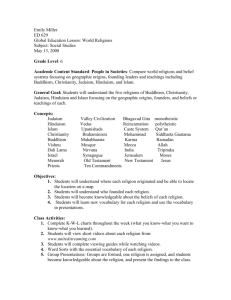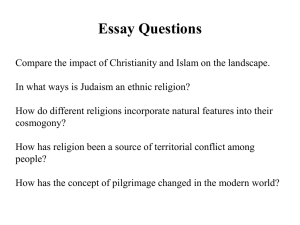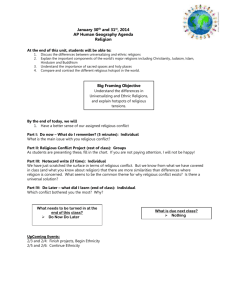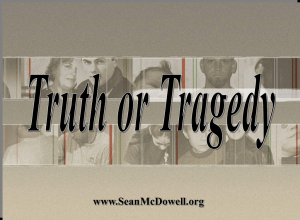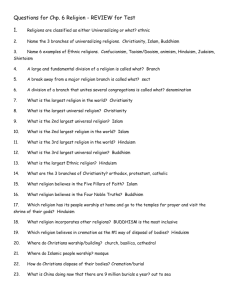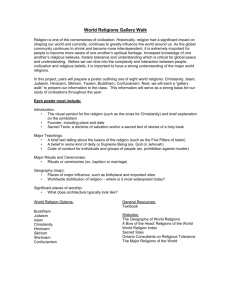AP Human Geography
advertisement
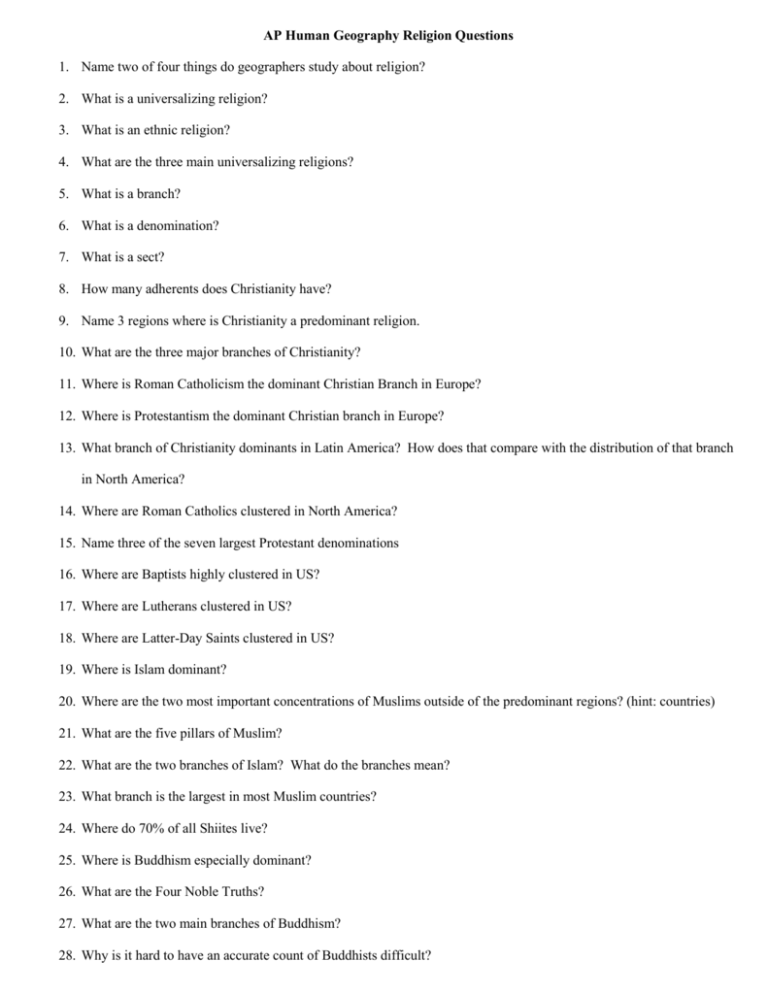
AP Human Geography Religion Questions 1. Name two of four things do geographers study about religion? 2. What is a universalizing religion? 3. What is an ethnic religion? 4. What are the three main universalizing religions? 5. What is a branch? 6. What is a denomination? 7. What is a sect? 8. How many adherents does Christianity have? 9. Name 3 regions where is Christianity a predominant religion. 10. What are the three major branches of Christianity? 11. Where is Roman Catholicism the dominant Christian Branch in Europe? 12. Where is Protestantism the dominant Christian branch in Europe? 13. What branch of Christianity dominants in Latin America? How does that compare with the distribution of that branch in North America? 14. Where are Roman Catholics clustered in North America? 15. Name three of the seven largest Protestant denominations 16. Where are Baptists highly clustered in US? 17. Where are Lutherans clustered in US? 18. Where are Latter-Day Saints clustered in US? 19. Where is Islam dominant? 20. Where are the two most important concentrations of Muslims outside of the predominant regions? (hint: countries) 21. What are the five pillars of Muslim? 22. What are the two branches of Islam? What do the branches mean? 23. What branch is the largest in most Muslim countries? 24. Where do 70% of all Shiites live? 25. Where is Buddhism especially dominant? 26. What are the Four Noble Truths? 27. What are the two main branches of Buddhism? 28. Why is it hard to have an accurate count of Buddhists difficult? 29. What is the ethnic religion with the largest number of followers? 30. How does Hinduism rank with all the religions in the world? 31. How are ethnic religions distributed? 32. Where are Hindus concentrated? 33. What do Hindus believe about the path to reach God? 34. What is the Hindu holy book? 35. If one person practices Hinduism in a particular way, what will be thought of them? 36. Why does Buddhism not compete with adherents with Confucianism, Daoism, and other ethnic religions in China? 37. Who was Confucius? 38. Why is Confucianism an ethnic religion? 39. Who organized Daoism? 40. What does dao mean? 41. When and where was Daoism banned? Is it still practiced today? 42. What do Ancient Shintoists believe about nature? 43. In what state is Shinto most predominant? 44. Describe the distribution of Judaism in the world. List 2 states. 45. Describe the treatment/population of Jews in the former Soviet Union since the late 1980’s. 46. What two universalizing religions find some of their roots in Judaism? 47. What is significant about the Judaism belief in God? 48. What is monotheism and polytheism? 49. What is animism? 50. Why is relatively little known about African religions? 51. What are African animist religions based on? 52. What is the cause of the rapid decline in animists in Africa? 53. What is a similarity among the origins of the three universalizing religions? 54. What was Christianity founded upon? 55. What do Roman Catholics accept besides the teachings of the Bible? 56. What was the cause of the split between the Roman and Eastern churches? 57. What are the roots of Protestantism? 58. What other faiths does Islam trace its origin to? 59. What do Christianity, Judaism, and Islam believe about Adam and Abraham? 60. Who eventually became the Prophet of Islam? 61. When and where was Muhammad born? 62. Where do the differences between the two main branches of Islam go to? 63. Who was the founder of Buddhism? 64. What is different about the origin of Hinduism from Christanity, Islam, and Buddhism? 65. What is a major difference between the 3 universalizing religions and ethnic religions in diffusion? 66. What forms of diffusion did Christianity diffuse by? 67. How did Christianity first diffuse? 68. What are missionaries? 69. What is a pagan? 70. How did Christianity become dominant in other parts of the world? 71. Why is Latin America predominantly Roman Catholic? 72. Why do Canada and the US have Protestant majorities? 73. Why are some regions in Canada and the US predominantly Catholic? 74. Describe the Mormon diffusion? Why are they in Utah? 75. How did Islam diffuse to Indonesia? 76. How does the diffusion of universalizing religions affect ethnic religions? 77. What religion has mingled with most other ethnic religions in East Asia? 78. What two religions are widely merged in Japan? 79. Why is the spatial distribution of Jews different from that of other ethnic religions? 80. What is a pilgrimage? What religions encourage pilgrimages? 81. What is the holiest city for Muslims? 82. What is the significance of the Ka’ba? 83. Which is the holiest river in India? Why? 84. What is a pagoda? 85. How do Hindus generally dispose of bodies? 86. What is a hierarchal religion? 87. What is fundamentalism? AP Human Geography Religion Answers 1. Distinctive place of origin of religions, the extent of diffusion of religions from their places of origin, the processes by which religions diffused to other locations, and the religious practices and beliefs that lead some religions to have more widespread distributions 2. One that attempts to be global, to appeal to all people, wherever they may live in the world 3. One that appeals primarily to one group of people living in one place 4. Islam, Christianity, Buddhism 5. A large and fundamental division within a religion 6. A division of a branch that unites a number of local congregations in a single legal/administrative body 7. A relatively small group that has broken away from an established denomination 8. 2 billion adherents, far more than any other world religion and has the most widespread distribution 9. North America, South America, Europe, and Australia; countries w/ a Christian majority exist in Africa and Asia as well 10. Eastern Orthodox-11%, Roman Catholic-50%, Protestant-24%; 11. southwest and east 12. northwest and Eastern Orthodoxy in the east and southeast 13. Roman Catholic; only 30% of North America is Roman Catholic 14. SW and NE US and Quebec 15. Baptist, Methodist, Pentecostal, Lutheran, Latter-Day Saint, Presbyterian, Episcopal 16. southeast 17. upper Midwest 18. Utah 19. from N Africa to Central Asia; Morocco to Pakistan 20. Indonesia and Bangladesh 21. There is no god worthy of worship except the one God, the source of all creation and Muhammad is the messenger of God; 5 times daily a Muslim prays, facing the city of Mecca, as a direct link to God; A Muslim gives generously to charity as an act of purification and growth; A Muslim fasts during the month of Ramadan, as an act of self-purification; If physically/financially able, A Muslim makes a pilgrimage to Mecca 22. Shiite-sectarian; Sunni-orthodox 23. Sunni; 83% 24. Iran; 90% 25. China and Southeast Asia 26. All living beings must endure suffering; Suffering, which is caused by a desire to live, leads to reincarnation; the goal of all existence is to escape from suffering and the endless cycle of reincarnation into Nirvana, which is achieved through mental and moral self-purification; Nirvana is attained through an 8-fold path, which includes rightness of belief, resolve, speech, action, livelihood, effort, thought, and meditation 27. Theravada and Mahayana 28. Only a few people in Buddhist countries participate in Buddhist institutions; Buddhism can be combined with other religions 29. Hinduism 30. 3rd after Christianity and Islam 31. Much more clustered than universalizing religions 32. India-97%; Nepal-2%; rest of world-1% 33. There is more than one way to reach God because people start from different backgrounds/experiences 34. Hinduism does not have a central authority or a single holy book; each individual selects suitable rituals 35. It is not considered a mistake or a stray from the orthodox doctrine 36. Many Chinese accept the teachings of both universalizing and ethnic religions 37. A philosopher and teacher in the Chinese province of Lu 38. It is especially strongly rotted in traditional values important to Chinese people 39. Lao-Zi 40. dao-way or path 41. It was banned in China by the Communists in 1949; still practiced in China and legal in Taiwan 42. Consider forces of nature to be divine esp. the Sun and Moon 43. Japan 44. 6million-US; 4 million-Israel; 2 million-former Soviet Union republics; 2 million-somewhere else 45. The number of Jews living in the former Soviet Union has declined rapidly when emigration laws were liberalized; for many years, their religious practices were strongly discouraged but few were able to emigrate 46. Christianity and Islam; Jesus was born a Jew and Muhammad traced his ancestry to Abraham 47. It was the first recorded religion to espouse monotheism, belief that there is only one God 48. Monotheism-one God; Polytheism-collection of gods 49. belief that objects, such as plants and stones, or natural events, like thunderstorms and earthquakes have a discrete spirit and conscious life 50. Few holy books or other written documents have come down from ancestors; By word of mouth 51. Monotheistic concepts; below the supreme god there is a hierarchy of divinities 52. The increases in the numbers of Christians and Muslims; the growth of the two universalizing religions is at the expense of ethnic religions 53. Can be traced to the actions and teachings of a man who lived since the start of recorded history 54. The teachings of Jesus 55. The interpretation of those teachings by the Church hierarchy, headed by the Pope 56. As a result of the rivalry between the Pope of Rome and the Patriarchy of Constantinople, which was especially intense after the collapse of the Roman Empire 57. Originated with the principles of the Reformation in the 16 th century; when Martin Luther posted 95 theses on the door of the church at Wittenberg, Individuals had primary responsibility for achieving personal salvation through direct communication with God; Grace is achieved through faith rather than through sacraments 58. the same narrative as Judaism and Christianity 59. Adam-first man; Abraham-one of this descendants 60. Muhammad 61. Mecca about 570 62. Back to the earliest days of Islam, and basically reflect disagreement over the line of succession in Islam leadership 63. Siddhartha Guatama; born about 563 B.C. in Lumbini in present-day Nepal 64. Hinduism existed prior to recorded history 65. The 3 universalizing religions diffused from specific hearths to other regions of the world while ethnic religions typically remained clustered in one location 66. Relocation, Hierarchical, and contagious 67. Relocation-missionaries carried the teachings of Jesus along the Roman Empire’s protected sea routes and excellent road network to people in other locations; Paul of Tarsus, a disciple of Jesus, traveled especially extensively through the Roman Empire as a missionary 68. individuals who help to transmit a universalizing religion through relocation diffusion 69. the word for a polytheistic follower in ancient times deriving from the Latin word for countryside 70. Through permanent resettlement of Europeans, Christianity became the dominant religion in N and S America, Australia, and New Zealand; conversions of indigenous populations and by intermarriage; In recent decades it diffused to Africa where it is now the most widely practiced religion 71. Their territory was colonized by the Spanish and Portuguese 72. Their early colonists came primarily from Protestant England 73. Immigration from predominantly Roman Catholic countries 74. At first the Mormons settled in Fayette, NY, but after the death of their founder Joseph Smith, the group moved several times in search of religious freedom; eventually under the leadership of Brigham Young, they migrated to the sparsely inhabited Salt Lake Valley 75. Arab traders that brought the religion there in the 13 th century 76. The diffusion of universalizing religions esp. Christianity and Islam come at the expense of ethnic religions 77. Buddhism 78. Shintoism and Buddhism 79. Judaism is practiced in many countries not just its place of origin 80. A journey for religious purposes to a place considered sacred; Hinduism and Islam 81. Mecca, the birthplace of Muhammad 82. It is thought to have been built by Abraham and Ishmael and contains a black stone given to Abraham by Gabriel as a sign of the covenant with Ishmael and the Muslim people 83. The Ganges River, because it is supposed to spring forth from the hair of Siva; Hardwar 84. a prominent and visually attractive element of the Buddhist and Shintoist landscapes 85. Cremation because it is considered an act of purification; children, ascetics, and people with certain diseases 86. A religion in which a central authority exercises a high degree of control. 87. A literal interpretation and a strict and intense adherence to basic principles of a religion

